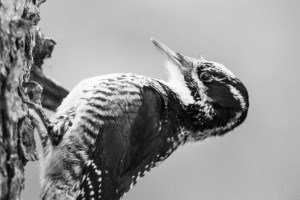When driving west from Jasper to British Columbia, one can’t ignore the large swaths of red-needled pine trees that have succumbed to the one-two punch of mountain pine beetle and the lethal fungus it carries. It’s hard to believe that a beetle the size of a short grain of rice is capable of killing a pine tree that has been around since before the First World War. In fact, it takes millions of them boring through the bark and tunneling around a forest’s innards to provide the momentum behind an epidemic. Millions. Which is a good thing if you’re a woodpecker. Jasper National Park has become your beetle buffet.

If you hike around Pyramid Bench, you may see beetle-killed trees that have been stripped bare of their bark by woodpeckers, flickers and sapsuckers hunting for food. The populations of these bark-banging birds are increasing as more food becomes available to them. Newly dead trees are hot real-estate for the cavity nesters in the family–those that enjoy the warmth and protection of a hole hollowed into a tree.
These birds are under-the-bark specialists, and each of their beaks is designed to take advantage of a particular niche. One of the most common species, the downy woodpecker, has a chisel-like beak that can get into tiny crevices to nab insect larva and other burrowing insects. Like many woodpeckers, it has feathered nostrils to protect its nasal passages from flying sawdust as it whittles away.
Then there’s the three-toed woodpecker, specializing in wood-chipping. After listening closely for movement of larva or adult insects, it flakes off the bark to expose them. You can see these bark flake piles at the bottom of trees along the Marjorie Lake Trail and Discovery Trail along the back of town.
With so many woodpeckers around, it would be easy to take them for granted. But don’t, because their head anatomy alone is so complex, scientists are still working to understand it. Hidden inside their bills are tongues often four times the length of their beak. Like your vacuum cleaner sucking the cord back in, they store these snaky appendages in two curved, rod-like structures (the hyoid horns) that wrap around the back of their head. The tongues, often barbed, are designed to slither around in holes and under the bark to ferret out crawlies.
Cool tongues, and we’re just getting started on amazing anatomical features. Woodpeckers have multiple clever mechanisms that allow them to hammer at trees (and in our neighbourhood, streetlights). For example, the aforementioned hyoid horns might also act as a harness to hold the skull in place. Their beaks are self-sharpening, so that when they strike wood with them, they move into the wood as opposed to stopping dead. Their jaws are also specially designed. Research recently revealed that woodpeckers’ jaws deform on impact–the bones literally slide out of place to absorb the shock before reforming. Also, their skull is thick and spongy, made of microscopic bits of bone that act like a structural mesh to protect them.
All of these features, along with strong neck muscles, combine to (according to one study) deflect 99.7 per cent of the impact energy away from the brain, thereby preventing brain injury. In short, woodpeckers are highly adapted creatures that may even hold the inspiration for technology that will help us protect our own brains. If we have to have a mountain pine beetle infestation, why not make the most of it? Go have a walk in woodpecker paradise.
Nikki Wilson Special to the 51����
